What is a catapult? The general definition is that a catapult is a machine that stores energy then quickly releases the energy to fire a projectile. To be a catapult the machine generally has to be too large for a person to carry. If we just used the storage and release of energy to define a catapult then a longbow would also fit this definition. So the size of the machine is important.
How did catapults develop? Catapults are an offshoot of the Crossbow. Over time crossbows got larger and larger. The went from being a hand-held weapon to something called the Belly-Bow which were so large they had to be braced against a knight's belly. From there they got even larger and became something called a stand crossbow where they were mounted on stands. Eventually they got large enough to be defined as something in their own right and no longer crossbows. This size change also brought about changes in how they operated.
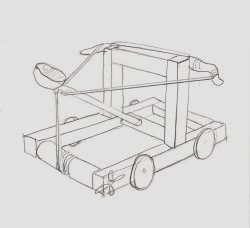
When did the first catapults appear and where? The earliest writings of catalpults were that they originated in China around the 3rd and 4th Century BC and this type of catapult was much like a big crossbow. They stood around 8 feet tall. The illustration here shows this early type of catapult. You can see by the design that it is a natural extension of the crossbow. It is pretty much a very big crossbow! But the unique development that turns it into what we consider to be a catapult is the swinging arm. This is mounted on a pivot and thus we have a catapult. The crossbow string itself is not used to fire the projectile, it is used to move the arm which hold the projectile.
<
BOOKS
Want to build a bigger, better, more powerful or fancier catapult? There are some great books available to you. These books, available at Amazon.com will help take your catapult building to new heights! Pun intended!

Ancient and Medieval Siege Weapons: A Fully Illustrated Guide To Siege Weapons And Tactics
In this richly illustrated guide, author Konstantin Nossov masterfully analyzes and recreates the weaponry, tactics, and stratagems of the ancient world. He offers first a comprehensive history of siege warfare in Ancient Egypt, Assyria, Judea, Persia, Greece, and Rome as well as Gaul, the Byzantine Empire, the Muslim world, and Medieval Europe. Discover, among other weapons, how scaling ladders, battering rams, borers, siege towers, throwing machines, and finally cannons developed over time. Numerous charts, illustrations, photographs, and tables explain how engineers constructed and adjusted these weapons and how warriors employed them on the battlefield. Chapters on methods of attack and defense show the weapons in action and reveal the various strategies used to implement and to overcome them. Based on an in-depth analysis of the work of ancient engineers, historians, and generals-including Apollodorus, Herodotus, Julius Caesar, Leonardo da Vinci, Livy, Plutarch, Thucydides, Vitruvius, and others- Ancient and Medieval Siege Weapons not only shows you how to recreate the siege weapons themselves but provides a deeper, clearer picture of the history of war.
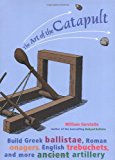
The Art of the Catapult: Build Greek Ballistae, Roman Onagers, English Trebuchets, and More Ancient Artillery
Whether playing at defending their own castle or simply chucking pumpkins over a fence, wannabe marauders and tinkerers will become fast acquainted with Ludgar, the War Wolf, Ill Neighbor, Cabulus, and the Wild Donkey-ancient artillery devices known commonly as catapults. Building these simple yet sophisticated machines introduces fundamentals of math and physics using levers, force, torsion, tension, and traction. Instructions and diagrams illustrate how to build seven authentic working model catapults, including an early Greek ballista, a Roman onager, and the apex of catapult technology, the English trebuchet. Additional projects include learning how to lash and make rope and how to construct and use a hand sling and a staff sling. The colorful history of siege warfare is explored through the stories of Alexander the Great and his battle of Tyre; Saladin, Richard the Lionheart, and the Third Crusade; pirate-turned-soldier John Crabbe and his ship-mounted catapults; and Edward I of England and his battle against the Scots at Stirling Castle. stantin Nossov masterfully analyzes and recreates the weaponry, tactics, and stratagems of the ancient world. He offers first a comprehensive history of siege warfare in Ancient Egypt, Assyria, Judea, Persia, Greece, and Rome as well as Gaul, the Byzantine Empire, the Muslim world, and Medieval Europe. Discover, among other weapons, how scaling ladders, battering rams, borers, siege towers, throwing machines, and finally cannons developed over time. Numerous charts, illustrations, photographs, and tables explain how engineers constructed and adjusted these weapons and how warriors employed them on the battlefield. Chapters on methods of attack and defense show the weapons in action and reveal the various strategies used to implement and to overcome them. Based on an in-depth analysis of the work of ancient engineers, historians, and generals-including Apollodorus, Herodotus, Julius Caesar, Leonardo da Vinci, Livy, Plutarch, Thucydides, Vitruvius, and others- Ancient and Medieval Siege Weapons not only shows you how to recreate the siege weapons themselves but provides a deeper, clearer picture of the history of war.
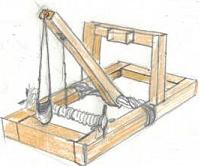
The Developmental History of the Catapult - Explanation with Drawings of how catapults developed. Starting with the Crossbow and evolving into bigger and more powerful siege engines. The development of the Catapult
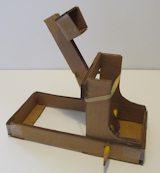
Make a Cardboard Catapult
This is an easy project for a powerful catapult. You need almost nothing to make it. I give you the template. Cut out the pieces and glue it together. Make a Cardboard Catapult
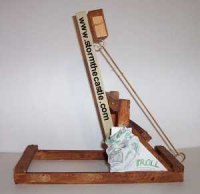
Table top catapult: The Troll
Rubber band powered
Kits and More Siege Engine Projects
Another Interesting Project: How to Build a Trebuchet

The Trebuchet was a unique siege engine of the middle ages. It was extraordinarily powerful and was easier for military engineers to build because it used gravity as the energy source. I also have a complete project on how to make the Little Dragon Trebuchet.
Catapults and Siege Engines
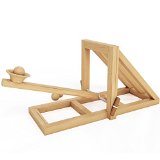
MOTA Catapult - Desktop Battle Kit -
- Engage in a fun hands-on learning experience and build your own desktop catapult with the included easy-to-understand instructions and pre-cut wooden pieces
- Test your precision and your catapult's power, or change the trajectory angle with the adjustable cord
- Take aim and fire away with five lightweight wooden ammo that's safe for indoor use
- Replicate the ancient art of war, or learn about the physics and engineering while constructing the catapult
- Guaranteed fun for all ages, imagination and wood glue not included
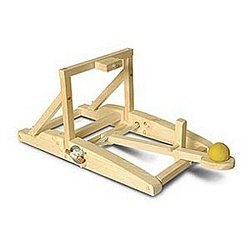
Working Wood Catapult DIY Kit, 6" X 5" X 10"
A fun, wooden catapult DIY kit for all ages to enjoy. Every piece is already pre-cut for you as you will not need to make other hard drilling work. All you need to do is assemble following the instruction and you will have a working catapult in no time. You may enjoy it with another friend or family to see this medieval wonder comes to life.
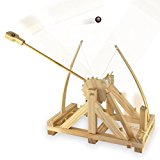
Leonardo DaVinci Catapult Kit
- Comes complete with all pieces pre-cut and ready to assemble
- Glue included
- Suitable for beginner model makers
- Easy to understand instructions
What good is a catapult if you don't have a castle to attack!
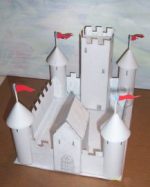
I have another project you might like. It is the Paper Castle and it has everything you could want in a castle making project including all the art work you can download. You just follow the instructions and make it yourself with some glue and cereal boxes. Build a Paper and Cardboard Castle It also has a learning sheet that helps to learn about castles when you are building it.
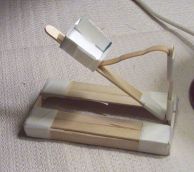
If you are looking for something easier to make you might want to try my project on making a popsicle stick catapult. Fast, easy and fun project! Goes great with the paper medieval castle. Make a popsicle stick catapult

Storm The Castle Catapult Game - Build a Popsicle stick catapult and hurl paper balls at the castle. How to make the Game and the catapult are here
|
![]()


















